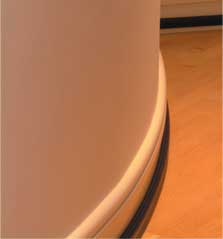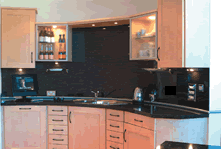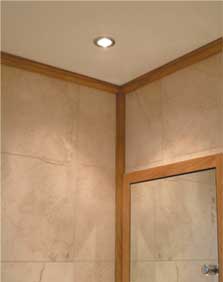How
many times can the hinge be opened?
It
can be opened and closed thousands of times, millions
probably!
Can
one increase the Ingress Protection rating of a
D-Line installation?
Yes.
The lengths are IP65, but the open backed accessories
are only IP20 (finger-safe). They could of course
be sealed to make the entire installation IP65.

 Can
D-Line be bent?
Can
D-Line be bent?
Sure,
on a gentle radius (but not the quarter sphere!)
See installation in a luxury kitchen where the installer
did not want to drill through marble bench. Please
see also (if you can notice it!) 30 x 15 above a
skirting board.
Is D-Line low smoke zero halogen?
D-Line
is self-extinguishing. However it is PVC and thus
does have halogens, so it is not LSOH. Please note
at glow wire testing (550ºC) flames were self-extinguishing
within 30 seconds of combustion.
What
inspired D-Line?
It
was actually an electrical installer who wanted
a much quicker fix than having to recess, but a
better look than box-trunking. It seemed such an
obvious request but marketplace and patent searches
revealed no alternatives. Then we considered trends
in homes and how modern objects tend to be stylised
by curves and chamfers, and how awkward recessing
is for DIY’ers also. Then a plumbing contractor
confirmed interest in the basic concept. At that
point we realised the market must be huge with so
many applications and potential demands, so we just
got on with it … but it’s taken three years to develop
the full range.
Could
anyone mistake the wood-effect for the real thing
and drill through wires?
We
cannot imagine this, given the clip-line groove
is visible. In this respect D-Lining is a safer
option vis-à-vis recessing, as you don’t need to
be drilling walls.
Is
D-Line patented?
Patents
are pending. Applications are now at advanced stages.
The products combine leading plastic–engineering
technologies with cutting-edge designs. In addition
to patents, we have more than thirty design registrations
approved in various territories.
What
is D-Line’s main competition?
First
recessing and secondly trunkings. For D-Line it
is marvellous that installers tell us they dislike
both in equal measure!
Can
D-Line be painted?
Yes,
though it’s colour range is designed to eliminate
the need. Of course rooms change colour, so yes
D-Line can accept Emulsion and gloss paint as long
as the surface is keyed using a sandpaper or similar.
Ideally where possible use Plastikote – or
similar but not necessary. Please beware however
that paint may flake on re-opening, so it looses
its accessibility appeal. Other trunkings would
react exactly the same.
 Why does the D-Line brochure
show a recessed light if the wires are surface?
Why does the D-Line brochure
show a recessed light if the wires are surface?
Here
the cables run up the tiled walls using the quarter
sphere as a coving. The installer cut a hole in
the top corner and fed cables across to a prepared
cut-out, wired the light, then fixed it from the
underside.
They could never have got behind the walls, which
were already tiled. The cornice infact provides
a decorative edging to the tiles.
It seems easy to use, much
easier than alternatives. Are there any snags?
It’s
been designed to be simple, much easier. That is
why it is so labour-saving. Three points to bear
in mind
Remember
to leave a space (between D-Lines) equal to the fascia
of the accessory you want to retro-fit.
Are
the alignments between lengths and accessories always
perfect?
As
close as can be, but please bear in mind D-Line
is combining lengths produced by extrusion processes,
with accessories made by injection mould processes,
and plastics are subject to slight variances / tolerances.
If ever a slight difference does occur it is usually
always on the underside which is below eye-level
so barely visible.
D-Line
recommend clip to be at the top side. Can it be
at the base instead?
Yes
an installation can be reversed, but the lid is
not so effective as a cable retainer assist in this
manner. You could circumvent cables dropping by
using an adhesive product, or fix a tie-wrap base
for example.
Can
I just use D-Line as a trim?
Of
course, as a frame or edging it’s easier than solid
woods with no need to mitre corners for example.
It is quicker to fix than wood, and of course looks
great with usually no need to paint later.
What
are the best choice wiring accessories to compliment
the switch and socket boxes?
At
the time of writing we have launched with a square
edged box so best use a square edged socket (UK
Spec); by early August latest there will be rounded
edge boxes too to accommodate rounded-edge sockets
(UK Spec). We can quickly design other boxes for
other non-UK markets too … please enquire. These
will follow.
Is
the clip-opening child-proof?
Yes,
we spent a lot of time and trial-and-error achieving
the best trade-off between accessibility and security.
D-Line is best opened by applying finger pressure
just above the clip mechanism. For the smallest
profile (16 x 8) the user can use the groove as
a nail-grip.
There is a knack to it, it does not just pop open!
Remember its shape, with no sharp edges, makes it
child friendly too!
Please
can you provide a guide to capacity for fitting
popular cable types, such as twin and earth, 3 core
flexes, and low-voltage comms type cables?
Good
question, here it is …
Fig 1.
|
|
Cable (twin and earth) flat
6242Y
|
|
D-Line profile
|
1.5mm
|
2.5mm
|
4mm
|
6mm
|
10mm
|
|
16 x 8
|
|
|
|
|
|
|
30 x 15
|
2 cables
|
2 cables
|
1 cable
|
1 cable
|
No
|
|
30 x 30 ¼
|
4 cables
|
3 cables
|
3 cables
|
2 cables
|
1 cable
|
|
50 x 25
|
8 cables
|
6 cables
|
4 cables
|
3 cables
|
2 cables
|
|
60 x 30
|
10 cables
|
8 cables
|
6 cables
|
4 cables
|
3 cables
|
|
This is only a guide and should
not be used as technical information
|
Fig
2.
|
|
Cable (3 core PVC flex) 3183Y
|
|
D-Line profile
|
0.75mm
|
1.0mm
|
1.5mm
|
2.5mm
|
|
16 x 8
|
1 cable
|
|
|
|
|
30 x 15
|
4 cables
|
3 cables
|
1 cable
|
1 cable
|
|
30 x 30 ¼
|
6 cables
|
4 cables
|
3 cables
|
2 cables
|
|
50 x 25
|
8 cables
|
6 cables
|
5 cables
|
4 cables
|
|
60 x 30
|
10 cables
|
9 cables
|
7 cables
|
5 cables
|
|
This is only a guide and should
not be used as technical information
|
Note
The above allow for bending radius. Straight runs
could accommodate additional cables.
Having
a 30 x 15 knockout on switch / socket boxes means
one cannot connect 2 x 2.5mm 3 core flexes, only
2 x 1.5mm 3 core or smaller.
|
D-Line size
|
Speaker Cable
|
Telephone Cable
|
Satellite / TV Cable
|
Data cable
|
|
16 x 8
|
|
|
|
|
|
30 x 15
|
|
|
|
|
|
30 x 30 ¼
|
|
|
|
|
|
50 x 25
|
|
|
|
|
|
60 x 30
|
|
|
|
|
|
This is only a guide using
most popular domestic and general commercial
wiring cable-types and should not be used
as technical information.
|
e-types and should not be used as technical information
Will
users still recess or continue to use mini-trunking?
In new builds with cavity walls which have not yet
been decorated and floors that have not been laid
recessing is comparatively easy and can be relatively
quick. So we appreciate D-Line is orientated towards
retro-fits. Please consider though that house builders
will use it to provide cable paths for appliance
wire / alarms instead of traditional floor trim.
Similary, if appearance does not matter many people
will still opt for mini-trunking. It is after all
as cheap as it looks, and considered ok for such
places as boiler houses or airing cupboards for
example. At the other end, if installers have the
time and can afford to recess and then redecorate
etc., then we accept that recessing and having flush
sockets etc may still be preferred.
D-Line
is providing a third way, but two factors need to
coincide…first, appearance has to matter, because
D-Line looks good on any surface, and second time
needs to be valued. Regards appearance we offer
an advantage over mini-trunkings, and vis-à-vis
recessing we are so much easier and quicker (while
still looking good!)
It
is when these come together that D-Line becomes
the brand-of-choice, otherwise we expect mini-trunking
or recessing will understandably still find favour.